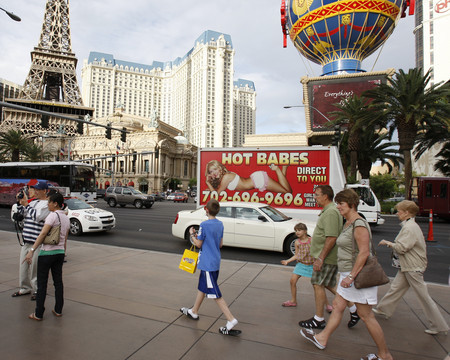Study says advertisers may be overlooking foot traffic on the Strip
It's painfully clear to anyone who has ever been stuck walking behind oblivious, dawdling tourists that Las Vegas Boulevard has a lot of pedestrians.
A new study says just how many, and suggests they may be an undervalued source of advertising revenue.
The study by Las Vegas research firm Applied Analysis was sponsored by outdoor media company Big Traffic and was the subject of a presentation Wednesday at Bali Hai Golf Club.
According to the presenters, it was the most in-depth look to date at pedestrian volumes on the Strip.
"Pedestrian traffic hasn't been one of the questions that came up," Jeremy Aguero of Applied Analysis said of customer research by the Las Vegas Convention and Visitors Authority and others.
That's why Big Traffic commissioned the study, to tell customers what they're getting for the money it costs to rent a mobile billboard.
The result?
According to surveys taken in March, as many as 40,000 people are walking on the Strip during peak hours.
That's enough people to fill Sam Boyd Stadium.
The number surprised even Aguero, who has for years been a prominent researcher of Las Vegas economic and demographic trends.
That's because the typical visitor spends about four days in town, and walks the Strip just one hour per day.
"That doesn't seem like that much time, but you start to do the multiplication. All of a sudden these numbers start to add up," he said.
With the information in hand, Big Traffic founder and CEO Maria Letizia says her companies, and others, can stop selling mobile and other pedestrian-oriented ads on emotion and start presenting harder cost-per-thousand views numbers.
"Never had the pedestrian traffic been counted," said Letizia, who founded her company in 2001. "Nor did any of the media companies that were buying for the major resorts think it was very important."
Letizia said her company pioneered mobile billboards in Las Vegas, but stressed it is not behind the notorious "Hot babes direct to you" billboards.
"We don't do any adult advertising whatsoever," she says. "We are a communications company, not an escort service that throws a truck out."
Letizia and Aguero said most of the research into people on the Strip is related to traffic or hotel rooms, not behavior as pedestrians.
Aguero said some specific segments of the Strip had been researched, and Letizia said she had sent students out with clickers to count walkers. Both claimed the latest study to be the most thorough and comprehensive in their experience.
Among other findings, the peak hours on the Strip for pedestrians are from 7 p.m. to midnight, with as many as 40,000 people per hour. Traffic bottoms out below 5,000 people per hour from 5 to 6 a.m.
People spend 424,000 hours on Strip sidewalks every day, which adds up to nearly 155 million annually.
"As they recall what they see, they are taking it home, whether it's to Florida or France," Aguero said.
Contact reporter Benjamin Spillman at bspillman@reviewjournal.com or 702-477-3861.
40,000
Number of pedestrians per hour on the Strip during the peak hours, from 7 p.m. to midnight
5,000
Number of people per hour from 5 to 6 a.m.
424,000
Number of combined hours spent by people on Strip sidewalks every day
155 million
Number of combined hours spent by people on Strip sidewalks every year


















